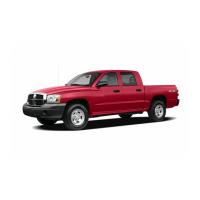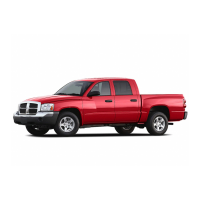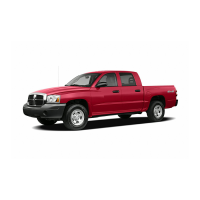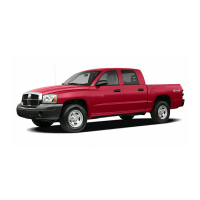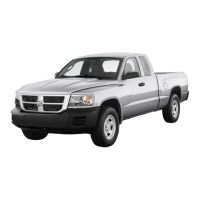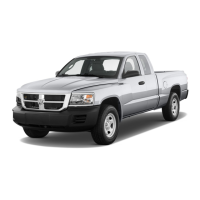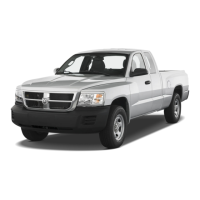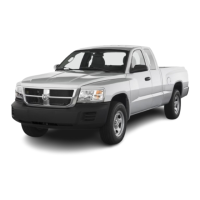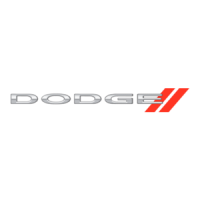Do you have a question about the Dodge Dakota 2008 and is the answer not in the manual?
Explains how to navigate and effectively use the owner's manual for information retrieval.
Highlights critical safety warnings and cautions to prevent injury and vehicle damage.
Instructions on how to remove the ignition key, especially for automatic transmissions.
Explains the Sentry Key Immobilizer system for preventing unauthorized vehicle operation.
Information on how the security alarm system monitors doors and ignition for unauthorized operation.
Explains how to use the remote keyless entry transmitter to lock/unlock doors and activate the panic alarm.
Details on how to start the vehicle remotely using the keyless entry transmitter.
Covers manual door locks, power door locks, child protection door locks, and automatic door locks.
Discusses the importance and usage of seat belts, knee bolsters, and airbags for occupant safety.
Details the driver and passenger airbag system, including types and deployment.
Guidelines for safely installing and using child restraint systems in the vehicle.
Explains the operation and features of the UConnect voice-activated communication system.
Details how to use the voice recognition system for controlling vehicle functions and audio.
How to activate, set, deactivate, and resume speed control for efficient driving.
Shows the estimated distance that can be traveled with the fuel remaining in the tank.
Explains the HomeLink system for operating garage doors and other devices.
Step-by-step instructions for programming HomeLink buttons to control devices.
Steps to reprogram a single HomeLink button without erasing other channels.
Details the vehicle's 12V auxiliary power outlets and their capabilities.
Detailed diagram and labeling of instrument cluster gauges and indicators.
Explains the function of various instrument cluster indicators and gauges.
Details RER multimedia system, including radio, satellite, navigation, and UConnect.
Steps for safely starting the vehicle, including seat and mirror adjustment.
Guidelines for operating the automatic transmission, including precautions and interlock systems.
Details on operating the NV233/243 transfer case and its modes.
Information on certification labels, weight ratings, payload, and loading procedures.
Safety tips, definitions, classifications, weights, and requirements for towing trailers.
Procedures for recreationally towing 2WD and 4WD models, including transfer case and transmission settings.
Instructions on how to use the hazard warning flasher for emergency signaling.
Detailed steps for changing a flat tire, including jack location and spare tire removal.
Procedures and safety precautions for jump-starting a vehicle's battery.
Techniques for moving a vehicle stuck in snow, sand, or mud using a rocking motion.
Information on the location and use of emergency tow hooks, with safety warnings.
Guidelines for properly towing a disabled vehicle, including methods for 4WD and 2WD.
Explains the OBD II system, Malfunction Indicator Light (MIL), and readiness for emissions tests.
Highlights the benefits of using authorized dealers for service and maintenance.
Covers checking engine oil level, changing oil, and engine oil selection criteria.
Checking coolant protection, level, and inspecting related components for leaks.
Covers front disc brakes, master cylinders, and brake fluid importance.
Covers manual transmission fluid level checks and lubricant selection.
Details automatic transmission fluid level checks and fluid/filter change recommendations.
Details the location and types of fuses and relays in the power distribution center.
Instructions for replacing headlight, park, and turn signal bulbs.
Step-by-step guide for replacing rear side marker, taillamp, stop, and turn signal bulbs.
Specifies engine oil viscosity, API certification, and capacity for different engines.
Provides capacities for the cooling system, including the coolant bottle for different engines.
Details fluids, lubricants, and genuine parts for the engine, including coolant and oil specifications.
Details fluids, lubricants, and genuine parts for the engine, including coolant and oil specifications.
Lists fluids, lubricants, and genuine parts for chassis components like transmissions, axles, and steering.
Highlights scheduled maintenance for the emission control system to ensure proper function.
Explains the oil change indicator system and general service reminders.
Items to check and replace during each engine oil change, including filter and brake inspection.
Details specific maintenance intervals for components like spark plugs, filters, and fluids based on mileage.
Special maintenance intervals for automatic transmission fluid and filter under severe usage conditions.
Special maintenance intervals for transfer case fluid under severe usage conditions.
Information on how authorized dealers provide service and what customers can expect.
Instructions on how to report safety defects to NHTSA and the manufacturer.
Explains how to navigate and effectively use the owner's manual for information retrieval.
Highlights critical safety warnings and cautions to prevent injury and vehicle damage.
Instructions on how to remove the ignition key, especially for automatic transmissions.
Explains the Sentry Key Immobilizer system for preventing unauthorized vehicle operation.
Information on how the security alarm system monitors doors and ignition for unauthorized operation.
Explains how to use the remote keyless entry transmitter to lock/unlock doors and activate the panic alarm.
Details on how to start the vehicle remotely using the keyless entry transmitter.
Covers manual door locks, power door locks, child protection door locks, and automatic door locks.
Discusses the importance and usage of seat belts, knee bolsters, and airbags for occupant safety.
Details the driver and passenger airbag system, including types and deployment.
Guidelines for safely installing and using child restraint systems in the vehicle.
Explains the operation and features of the UConnect voice-activated communication system.
Details how to use the voice recognition system for controlling vehicle functions and audio.
How to activate, set, deactivate, and resume speed control for efficient driving.
Shows the estimated distance that can be traveled with the fuel remaining in the tank.
Explains the HomeLink system for operating garage doors and other devices.
Step-by-step instructions for programming HomeLink buttons to control devices.
Steps to reprogram a single HomeLink button without erasing other channels.
Details the vehicle's 12V auxiliary power outlets and their capabilities.
Detailed diagram and labeling of instrument cluster gauges and indicators.
Explains the function of various instrument cluster indicators and gauges.
Details RER multimedia system, including radio, satellite, navigation, and UConnect.
Steps for safely starting the vehicle, including seat and mirror adjustment.
Guidelines for operating the automatic transmission, including precautions and interlock systems.
Details on operating the NV233/243 transfer case and its modes.
Information on certification labels, weight ratings, payload, and loading procedures.
Safety tips, definitions, classifications, weights, and requirements for towing trailers.
Procedures for recreationally towing 2WD and 4WD models, including transfer case and transmission settings.
Instructions on how to use the hazard warning flasher for emergency signaling.
Detailed steps for changing a flat tire, including jack location and spare tire removal.
Procedures and safety precautions for jump-starting a vehicle's battery.
Techniques for moving a vehicle stuck in snow, sand, or mud using a rocking motion.
Information on the location and use of emergency tow hooks, with safety warnings.
Guidelines for properly towing a disabled vehicle, including methods for 4WD and 2WD.
Explains the OBD II system, Malfunction Indicator Light (MIL), and readiness for emissions tests.
Highlights the benefits of using authorized dealers for service and maintenance.
Covers checking engine oil level, changing oil, and engine oil selection criteria.
Checking coolant protection, level, and inspecting related components for leaks.
Covers front disc brakes, master cylinders, and brake fluid importance.
Covers manual transmission fluid level checks and lubricant selection.
Details automatic transmission fluid level checks and fluid/filter change recommendations.
Details the location and types of fuses and relays in the power distribution center.
Instructions for replacing headlight, park, and turn signal bulbs.
Step-by-step guide for replacing rear side marker, taillamp, stop, and turn signal bulbs.
Specifies engine oil viscosity, API certification, and capacity for different engines.
Provides capacities for the cooling system, including the coolant bottle for different engines.
Details fluids, lubricants, and genuine parts for the engine, including coolant and oil specifications.
Details fluids, lubricants, and genuine parts for the engine, including coolant and oil specifications.
Lists fluids, lubricants, and genuine parts for chassis components like transmissions, axles, and steering.
Highlights scheduled maintenance for the emission control system to ensure proper function.
Explains the oil change indicator system and general service reminders.
Items to check and replace during each engine oil change, including filter and brake inspection.
Details specific maintenance intervals for components like spark plugs, filters, and fluids based on mileage.
Special maintenance intervals for automatic transmission fluid and filter under severe usage conditions.
Special maintenance intervals for transfer case fluid under severe usage conditions.
Information on how authorized dealers provide service and what customers can expect.
Instructions on how to report safety defects to NHTSA and the manufacturer.
| Brand | Dodge |
|---|---|
| Model | Dakota 2008 |
| Category | Automobile |
| Language | English |
